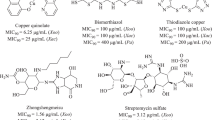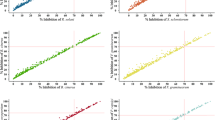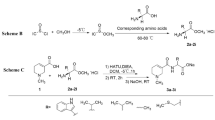Abstract
Global food security is one of the foremost challenges of our time and requires a multifaceted solution. Crop protection strategies are an essential part of this response; however, there is increasing resistance to known modes of action. Since its discovery in 1949, the natural product alternaric acid has been proposed as a starting point for herbicide development. However, this target is undeveloped due to its poor synthetic accessibility and a lack of knowledge of the associated pharmacology. Here we report the discovery of herbicidal compounds from alternaric acid that operate via a potentially unknown mode of action. Development of a total synthesis enabled structure–activity relationship profiling of compound libraries, which, combined with phenotypic screening and molecular modelling data, identified small-molecule lead compounds with enhanced and broader spectrum herbicidal activity than alternaric acid.

This is a preview of subscription content, access via your institution
Access options
Subscribe to this journal
Receive 12 digital issues and online access to articles
$119.00 per year
only $9.92 per issue
Buy this article
- Purchase on Springer Link
- Instant access to full article PDF
Prices may be subject to local taxes which are calculated during checkout







Similar content being viewed by others
Data availability
All data generated during this study are included in this published article (and its Supplementary Information files). Analytical data generated during the current study are also available in the University of St Andrews repository, https://doi.org/10.17630/c41bcf9c-57cc-46f2-94cf-c9f7559554c5. Crystallographic data for compound 2 are available from the Cambridge Crystallographic Data Centre (CCDC) under deposition number 2169366.
References
Godfray, H. C. J. et al. Food security: The challenge of feeding 9 billion people. Science 327, 812–818 (2010).
Hawkins, N. J., Bass, C., Dixon, A. & Neve, P. The evolutionary origins of pesticide resistance. Biol. Rev. 94, 135–155 (2019).
Jeschke, P. Progress of modern agricultural chemistry and future prospects. Pest Manag. Sci. 72, 433–455 (2016).
Fitton, N. et al. The vulnerabilities of agricultural land and food production to future water scarcity. Glob. Environ. Change 58, 101944 (2019).
Lamberth, C., Jeanmart, S., Luksch, T. & Plant, A. Current challenges and trends in the discovery of agrochemicals. Science 2013, 742–746 (2013). 341.
Loso, M. R. et al. Lead generation in crop protection research: a portfolio approach to agrochemical discovery. Pest Manag. Sci. 73, 678–685 (2017).
Mitchell, G. et al. Mesotrione: a new selective herbicide for use in maize. Pest Manag. Sci. 57, 120–128 (2001).
Grayson, B. T. et al. The physical and chemical properties of the herbicide cinmethylin. Pestic. Sci. 21, 143–153 (1987).
Sauter, H., Steglich, W. & Anke, T. Strobilurins: evolution of a new class of active substances. Angew. Chem. Int. Ed. 38, 1328–1349 (1999).
Bartlett, D. W. et al. The strobilurin fungicides. Pest Manag. Sci. 58, 649–662 (2002).
Loiseleur, O. Natural products in the discovery of agrochemicals. Chim. Int. J. Chem. 71, 810–822 (2017).
Curtis, P. J. et al. Synthesis of cinerone, cinerolone and of cinerin-I. Nature 164, 534–534 (1949).
Brian, P. W. et al. Alternaric acid; a biologically active metabolic product of Alternaria solani (Ell. & Mart.) Jones & Grout; its production, isolation and antifungal properties. J. Gen. Microbiol. 5, 619–632 (1951).
Elson, G. W., Hemming, H. G., Wright, J. M. & Brian, P. W. The phytotoxic properties of alternaric acid in relation to the etiology of plant diseases caused by Alternaria solani (Ell. & Mart.) Jones & Grout. Ann. Appl. Biol. 39, 308–321 (1952).
Shahbazi, H., Aminian, H., Sahebani, N. & Halterman, D. Effect of Alternaria solani exudates on resistant and susceptible potato cultivars from two different pathogen isolates. Plant Pathol. J. 27, 14–19 (2011).
Tabuchi, H. et al. Stereochemistry of alternaric acid: synthesis of the C9–C14 fragment. J. Org. Chem. 59, 4749–4759 (1994).
Tabuchi, H. et al. Total synthesis of alternaric acid. Tetrahedron Lett. 34, 2327–2330 (1993).
Tabuchi, H. & Ichihara, A. Structures and stereochemistries of new compounds related to alternaric acid. J. Chem. Soc., Perkin Trans. 1, 125–133 (1994).
Furuichi, N., Nishimura, S. & Langsdorf, G. Effect of alternaric acid, a toxin of Alternaria solani, on the hypersensitive response of potato to Phytophthora infestans. Ann. Phytopathol. Soc. Japan 58, 1–7 (1992).
Hassan, A. et al. Alternaric acid stimulates phosphorylation of His-tagged RiCDPK2, a calcium-dependent protein kinase in potato plants. Genet. Mol. Res. 11, 2381–2389 (2012).
Ichihara, A. Bioorganic chemistry of alternaric acid: stereochemistry, total synthesis and bioactivity. J. Synth. Org. Chem Jpn. 53, 975–986 (1995).
Probst, G. D., Schoop, A. & Trost, B. M. Ruthenium-catalyzed Alder ene type reactions. A formal synthesis of alternaric acid. J. Am. Chem. Soc. 120, 9228–9236 (1988).
Chemler, S. R., Trauner, D. & Danishefsky, S. J. The B-alkyl Suzuki–Miyaura cross-coupling reaction: development, mechanistic study, and applications in natural product synthesis. Angew. Chem. Int. Ed. 40, 4544–4568 (2001).
Kamer, P. C. J., Van Leeuwen, P. W. N. M. & Reek, J. N. H. Wide bite angle diphosphines: xantphos ligands in transition metal complexes and catalysis. Acc. Chem. Res. 34, 895–904 (2001).
Kolb, H. C., Vannieuwenhze, M. S. & Sharpless, K. B. Catalytic asymmetric dihydroxylation. Chem. Rev. 94, 2483–2547 (1994).
Gilman, S., Nishizawa, M. & Grieco, P. A. Organoselenium chemistry. A facile one-step synthesis of alkyl aryl selenides from alcohols. J. Org. Chem. 41, 1485–1486 (1976).
Indolese, A. F., Mueller, T. J. J., Treptow, B. & Trost, B. M. A Ru catalyzed addition of alkenes to alkynes. J. Am. Chem. Soc. 117, 615–623 (1995).
Machacek, M., Schnaderbeck, M. J. & Trost, B. M. A regioselective Ru-catalyzed alkene−alkyne coupling. Org. Lett. 2, 1761–1764 (2000).
Tabuchi, H., Hamamoto, T. & Ichihara, A. Modification of the Fries type rearrangement of the O-enol acyl group using N,N-dicyclohexyl-carbodiimide and 4-dimethylaminopyridine. Synlett 1993, 651–652 (1993).
Duke, S. O., Dayan, F. E., Romagni, J. G. & Rimando, A. M. Natural products as sources of herbicides: current status and future trends. Weed Res. 2000, 99–111 (2000).
Acknowledgements
E.M.I and A.J.B.W. thank Syngenta and EPSRC for an iCASE PhD studentship. We thank C. Martin and R. Ellis at the Syngenta Jealott’s Hill Chemistry Automation Platform for their support with reaction optimization and library purification.
Author information
Authors and Affiliations
Contributions
E.M.I. conceived and conducted the synthetic chemistry. J.C.-B. guided compound design and coordinated the biological screening. A.M.Z.S performed and analysed X-ray crystallography. E.M.I, J.C-B. and A.J.B.W. wrote the manuscript. A.J.B.W. conceived the chemistry and directed the project.
Corresponding author
Ethics declarations
Competing interests
The authors declare no competing interests.
Peer review
Peer review information
Nature Synthesis thanks Patrick Steel and the other, anonymous, reviewer(s) for their contribution to the peer review of this work. Primary handling editor: Alison Stoddart, in collaboration with the Nature Synthesis team.
Additional information
Publisher’s note Springer Nature remains neutral with regard to jurisdictional claims in published maps and institutional affiliations.
Supplementary information
Supplementary Information
Supplementary Discussion, Figs. 1 and 2, and Tables 1–8.
Supplementary Data 1
Crystallographic data for compound 2; CCDC no. 2169366.
Source data
Source Data Fig. 3
Excel file used to generate chart using data from Tables in SI (pS183-184).
Source Data Fig. 5
Excel file used to generate chart using data from Tables in SI (pS183-184).
Source Data Fig. 6
Excel file used to generate chart using data from Tables in SI (pS183-184).
Rights and permissions
Springer Nature or its licensor holds exclusive rights to this article under a publishing agreement with the author(s) or other rightsholder(s); author self-archiving of the accepted manuscript version of this article is solely governed by the terms of such publishing agreement and applicable law.
About this article
Cite this article
Israel, E.M., Comas-Barceló, J., Slawin, A.M.Z. et al. Total synthesis and structure–activity relationship of alternaric acid delivers an herbicide vector. Nat. Synth 1, 987–995 (2022). https://doi.org/10.1038/s44160-022-00169-3
Received:
Accepted:
Published:
Issue Date:
DOI: https://doi.org/10.1038/s44160-022-00169-3



